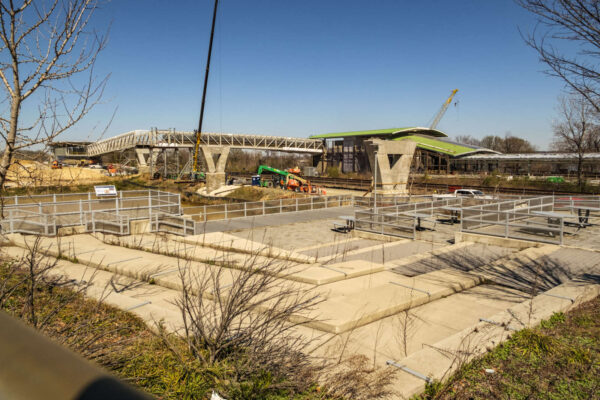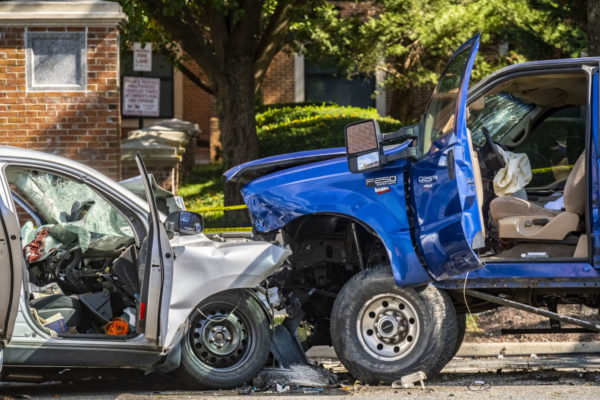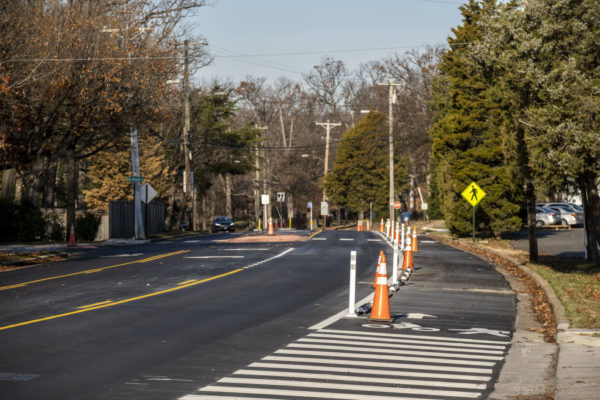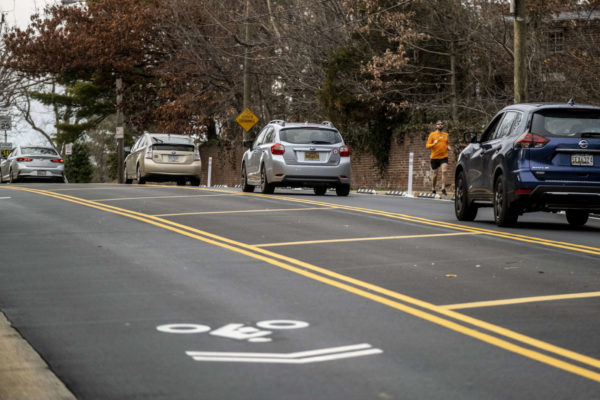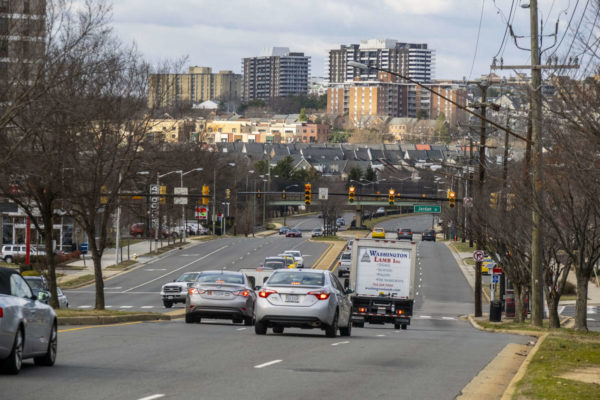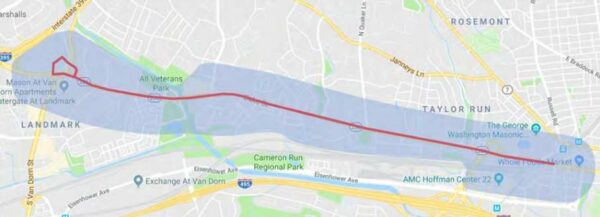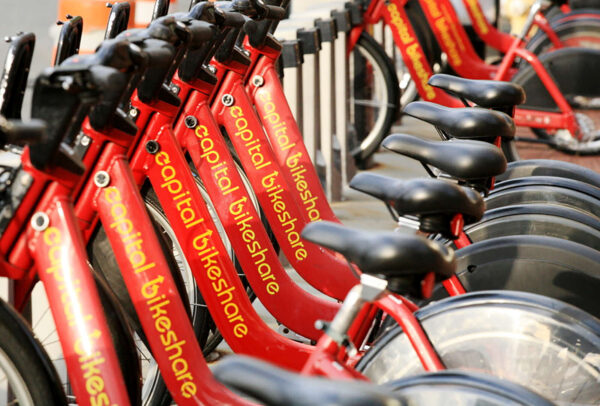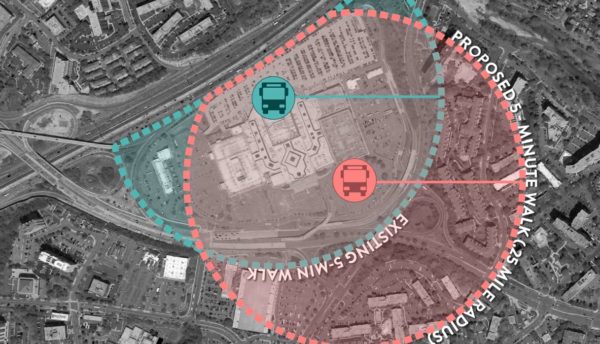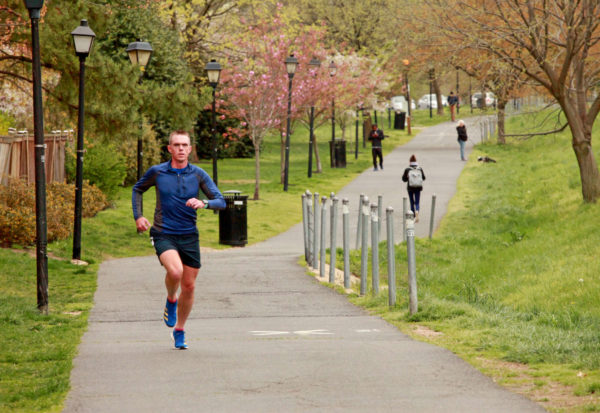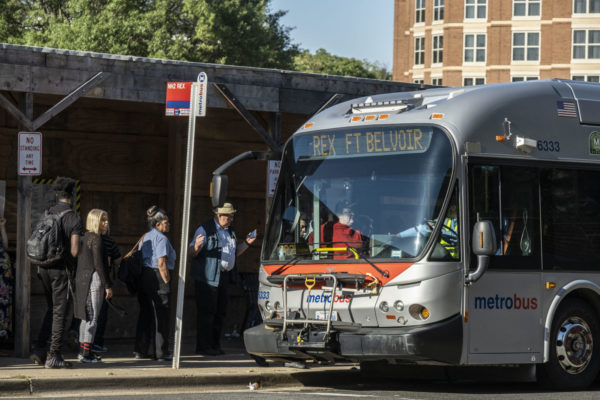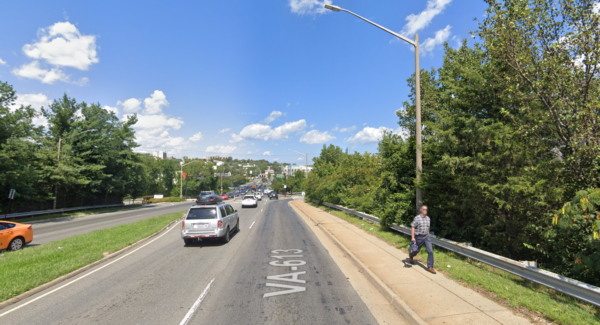
Two projects in Alexandria will receive $5 million apiece from the Northern Virginia Transportation Authority (NVTA).
The NVTA awarded the amounts as part of its six-year budget adopted on Thursday (July 14). The two projects are: to make S. Van Dorn Street and its bridge more transit and pedestrian-friendly for the West End Transitway, and replacement of a fair-weather crossing on the Holmes Run Trail, just behind William Ramsay Elementary School (5700 Sanger Avenue).
The West End Transitway project is needed as significant redevelopment and a new bus rapid transit route are planned for the area.
The South Van Dorn Street bridge near the Van Dorn Metro station is a four-lane crossing that connects the Van Dorn neighborhood with Landmark just to the north. The project will design dedicated transit lanes for the future West End Transitway on S. Van Dorn Street and the Van Dorn bridges between Metro Road and McConnell Avenue, a report states.
This project will also improve non-motorized facilities along the bridges for better connections between new developments and the Van Dorn Metrorail station. The existing Van Dorn Street bridge has a narrow sidewalk along the east side and no bicycle facilities.
The Holmes Run Trail crossing will be replaced with a prefabricated pedestrian and bicycle bridge.
“The project will allow trail users continuous, safe and reliable access to the City’s off-street trail facilities, as well as other regional trails, and the future West End Transitway,” according to the report.
NVTA gave out about $625 million to 20 projects total across the region with its latest program, with more than half the money going to projects in Fairfax County.
Photo via Google Maps
DASH is making some changes to the bus network in Old Town, including one change that has residents concerned.
At a meeting of the Transportation Commission yesterday, DASH Director of Planning & Marketing Martin Barna outlined plans to adjust DASH service in coordination with the opening of the Potomac Yard Metro station. Among those changes is one Barna said has proven contentious to residents along the affected route.
Route 34, which currently runs from the Lee Center to Braddock Road Metro station, will be changed to connect up to the Potomac Yard Metro station instead. As part of that change, DASH is planning to realign the route from N. Fairfax Street to N. Pitt Street.
“This is far and away the most contentious part of our proposal,” said Barna. “We’ve received 30-35 comments from residents along Pitt Street who don’t want to see DASH service along that street for parking and noise concerns.”
Barna said residents along the street have expressed concerns at more congestion caused by the new bus route, while DASH is hoping the shift will provide a more useful route through Old Town North.
“N. Fairfax street is well served by the 30 and 31, which are more frequent,” Barna said. “Nearly all ridership along that stretch are those [lines].”
Without this change, Barna said there will continue to be a four-block gap in DASH coverage between Washington Street and Fairfax Street. With new apartment complexes and grocery stores coming to that area, Barna said DASH saw the change as a good opportunity to potentially provide more service.
One of the other changes for Potomac Yard DASH routes is that the 33 and the 36, which currently go to Potomac Yard, will continue serving the shopping center but will go to the Metro station first.
“We’re trying to make sure the people trying to catch trains can go directly there,” Barna said.
Barna also provided the Transportation Commission with an update on the fare-free and electric bus programs. With DASH ridership going up, Commissioners asked Barna how much money was being taken off the table by the fare-free program.
“Last year council increased budget by $1.5 million to offset lost revenues,” Barna said. “Before the pandemic we were making $3.5-4 million in revenue but we’re not back to that point. It’s hard to say whether riding because fares are free or because they’d normally be riding.”
Barna said that $3.5 million could pay for around three electric buses, which are more expensive than diesel ones, but that DASH doesn’t currently have the infrastructure to support the additional buses anyway. DASH is currently “aggressively pursing grants” to boost the bus system’s electric infrastructure, Barna said, as well as working through the development process for a facilities expansion.
Nestled away in a budget presentation for the Transportation Commission, a report on ten years of crash data shows that crashes in Alexandria are overall on the decline.
The report includes data collected from 2011 to 2020, with a note that the COVID-19 pandemic likely impacted crash data from the final year of the study. But even pre-2020, the total number of car crashes in Alexandria had been fairly consistently declining year after year.
Crashes that involve kills or serious injuries (KSI) were more erratic over the years, remaining at a fairly consistent 3% of all crashes throughout the reporting period..
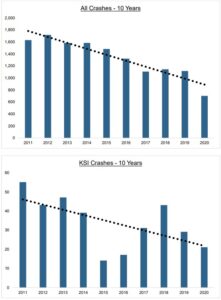 “Crash totals from 2011-2020 show a downward trend for all crashes, including those that involved fatal or severe injury,” the report said. “The 2016-2020 annual crash averages by all modes (vehicle-only, pedestrian, bicyclist) and crash type (all and KSI) are less than those seen during 2011-2015. Year over year, vehicle-only crashes had the highest number of KSI crashes followed by pedestrian and then bicyclist crashes.”
“Crash totals from 2011-2020 show a downward trend for all crashes, including those that involved fatal or severe injury,” the report said. “The 2016-2020 annual crash averages by all modes (vehicle-only, pedestrian, bicyclist) and crash type (all and KSI) are less than those seen during 2011-2015. Year over year, vehicle-only crashes had the highest number of KSI crashes followed by pedestrian and then bicyclist crashes.”
The report only covered crashes on city streets — not including crashes from major highways like I-395 or I-495. Vehicle-only crashes account for most of the KSI crashes each year, followed by those involving pedestrians then cyclists.
The study tracked other information on crashes, like location, time, weather, road conditions and more. The information put together a portrait of which crashes tend to be most fatal.
“During the weekday, high crash frequencies are seen during the evening commute,” the report said. “Early spring had the highest proportion of KSI crashes for bicyclists, while the late summer months were the highest for pedestrians.”
The report found that vehicle occupants who were not wearing seat belts were 20 times more likely to be killed or severely injured.
“Most vehicle occupants wore their safety restraint (e.g., seat belt) during crashes,” the report said. “However, vehicle occupants who did not wear their seatbelt were approximately 20 times more likely to be killed or severely injured compared to those who did wear their seatbelt.”
The report also noted that 58% of all KSI crashes occurred at intersections, and intersections with five points or more had the highest proportion of KSI crashes though the total number of crashes at these intersections were relatively low.
There were roughly the same number of crashes for bicyclists in locations where bike infrastructure was present as areas where there wasn’t, but areas without bicycle infrastructure had a higher fatality rate.
“Out of the eight KSI bicyclist crashes,” the report said, “seven had no presence of bike infrastructure.”
The full report is available in the docket (page 31 of the pdf, page 4 of the docket) for the Transportation Commission’s March 16 meeting.
In a meeting with the Transportation Commission, city staff said earlier reporting about the city axing the city-wide feedback form for the Complete Streets program sounded “scary”, emphasizing instead that the city will be focusing on feedback more local to the affected areas.
Quick refresher: Complete Streets is an Alexandria program that aims to redesign roadways for the benefit of all users, with pedestrians and cyclists in mind along with motorists. The program stirred up some local controversy over plans to reduce travel lanes on Seminary Road in favor of bike lanes.
The form in question here is a city-wide feedback form meant to collect public responses to Complete Streets proposals. But, as might be expected given some of the intense debates over a couple of earlier Complete Streets programs, the city said it was finding that the feedback collection was being bogged down with responses that might not have been relevant to the streets in question.
“The Complete Streets policy was adopted in 2011, began this feedback form in 2018 to get feedback from residents,” said Transportation Planning Division Chief Christopher Ziemann. “This hasn’t worked as well as we thought.”
Ziemann said public engagement will continue, particularly on major projects like the Rayburn & Reading Avenue Complete Streets Project and the Commonwealth Avenue Complete Streets Project, but for other Complete Streets initiatives, the focus would be shifted to outreach to areas closer to the project.
“Discontinuing [the] feedback form frees up resources to focus more targeted engagement on these types of projects,” Ziemann said.
Staff at the meeting said the decision is about how the city allocates its resources.
Other parts of the staff’s proposal include doing more to divest the Complete Streets program from the repaving schedule. In the presentation, staff recommended a “more proactive approach versus reacting to the paving schedule.” While the Complete Streets program would continue doing improvements alongside repaving, more complex projects could be implemented outside of the resurfacing schedule.
Alex Carroll, an urban planner with the city of Alexandria, explained the decision:
What we end up doing is either A. taking all hands on deck approach on [Complete Streets], which pulls away from other projects, B. rush projects into a short timeframe, or C. we end up having to delay the surfurfacing of the street which results in frustration with residents who just want their potholes fixed.
Staff is also recommending a more comprehensive five-year work plan for the Complete Streets program.
“The headline is very scary, that ‘the city doesn’t want your input’ but it’s a little bit more nuanced than that,” Carroll said.
In the midst of everything else that’s happened over the last year, the Seminary Road debate can feel like a relic of another age, but there was a time when the Complete Streets program was at the center of a community-wide debate.
Complete Streets is an Alexandria program that aims to redesign roadways for the benefit of all users, with pedestrians and cyclists in mind along with motorists. The program stirred up some local controversy over plans to reduce travel lanes on Seminary Road in favor of bike lanes. A form put out by the city allowed locals to weigh in on street resurfacing.
“In 2018, the City began issuing an annual Citywide feedback form for residents to provide input on streets that are being resurfaced,” staff said in a report. “Feedback is usually collected for non-local streets where striping improvements are potentially feasible. Staff analyzes all public comments and produces a report for each street to summarize resident feedback.”
A staff report said that each Complete Streets announcement often comes with significant feedback.
“Every year, staff develops a repaving feedback form to solicit community input on streets that are scheduled to be repaved in the coming paving season, accompanied by an eNews release, webpage updates, and social media engagement,” the report said. “Staff receives hundreds of community comments related to repaving each year, which are then analyzed and summarized in a report for each street. The intention is that this feedback would then be used to inform potential changes to those streets via repaving. The original of this effort was to garner feedback to improve service delivery.”
At a Transportation Commission meeting tomorrow, the city will consider a proposal (page 36) from staff to eliminate a form that allowed locals to offer input on the project, saying the form was often misused and wastes staff resources:
- Much of the community feedback is related to issues beyond the scope street resurfacing
- This results in wasted staff effort and a potential erosion of trust between City staff and
residents- Much feedback does not end up getting used
- The repaving form sometimes creates speculation about what the City is planning to do to
streets that are repaved, which can increase tensions in the community- This approach fails to set accurate or reasonable expectations
Staff are recommending that the form but eliminated in favor of more targeted local outreach.
The report also recommends longer-term planning for the Complete Streets program to help make implementation occur on a more reliable timeline.
“Staff recommends the development of a five-year work plan for Complete Streets with input from the Transportation Commission,” the report said. “This approach would generate clear expectations for residents, City Council, City boards and commissions, and staff for what Complete Streets improvements will be done. Staff anticipates this work plan would be developed in Fiscal Year 2023 and would consider crash data and equity to support and align with Vision Zero efforts.”
In the docket for an upcoming Transportation Commission meeting, city staff unveiled plans to open op a process to “define the future of Duke Street.”
In a 2008 Transportation Master Plan, the city identified several corridors through Alexandria as prime locations for transitways — redesigned streets to meant to emphasize high-frequency and reliable public transit. A 2012 concept plan further elaborated with a more detailed framework for what transitways would entail.
“The goal of these transitways is to deliver high capacity transit to areas of the City that are not adjacent to Metrorail,” the city report said. “These areas already see high transit ridership and are expecting significant development (as evidenced in the Small Area Plans). High capacity transit provides a means to manage congestion as well as connect residents and businesses to jobs and services within the City and throughout the region.”
The Transportation Meeting is scheduled for Wednesday, June 16.
A staff report on the project said that while transit improvements are the main focus, traffic management and bicycle/pedestrian access will also be included in the plans. The report said in November, the City Council agreed that staff needed to reevaluate
“Duke Street IN MOTION Week is the first step in that effort, which will help guide the revised plan for transit facilities and services on the corridor,” the city said.
That week of public programming is scheduled for June 21-27.
“Duke Street IN MOTION Week will include a virtual kick-off webinar on June 23, project website launch, and an online feedback form to help the team identify the communities’ needs and goals for the development of the corridor’s improvement alternatives,” the city said. “This will also include CDC compliant in-person pop-ups events and outreach to stakeholder groups and organizations along the corridor. Approximately 12 pop-ups will be hosted during Duke Street IN MOTION Week, with 6 additional pop-ups held after June 27.”
Over the summer, the staff report said the city would begin planning and working with a design consultant firm to develop conceptual plan alternatives and put together drawings and documents, with additional rounds of feedback in the fall. The total feedback period is scheduled to run for 18 months.
“The community will create a vision for this corridor to steer the eventual outcome of improvements related to public transit, such as the bus,,” the city said on the project website, “as well as other related improvements for walking, riding a bicycle, driving, and using micromobility (for example, shared electric bikes and scooters).”
Capital Bikeshare is expanding into Alexandria’s West End, with three new stations scheduled to be installed in June.
The expansion is part of a seven-station growth planned to expand the bike infrastructure network across the West End.
According to a report headed to the Transportation Commission, the four recently installed stations are:
- South Whiting Street at Lane Drive
- North Hampton Drive at Ford Avenue
- Taney Avenue at North Howard Street
- Kenmore Avenue at Seminary Road
The three incoming stations will be located at:
- Fillmore Avenue at Bisdorf Drive, southeast corner (on-street)
- North Howard Street at North Imboden Street (on-street)
- Virginia Theological Seminary
Once this stage is completed, there will be a total of 44 Capital Bikeshare stations in Alexandria, but the City is hoping to expand that again if it can get the funding this fall.
According to the report:
Staff is continuing to work towards the next phase of expansion with VDOT funding, which is expected to begin in fall/winter 2021 and will increase the Capital Bikeshare system by an additional 17 stations. The remaining 9 stations funded by VDOT grant funding are expected to be installed in 2022/2023.
The bikeshare expansion is scheduled for review at the Wednesday, May 19, Transportation Commission meeting.
As the city prepares to head into 2021, staff and Transportation Commissioners have been putting together a New Year’s resolution of top transit priorities for the next two fiscal years.
In a report prepared for tomorrow’s Transportation Commission meeting, 20 planned transit projects were ranked by their priority to staff and commission members.
The top scoring item was the Landmark Transit Hub, a planned nexus of bus rapid transit, Dash and Metro bus traffic in the West End.
“[The goal is to] provide an urban transit hub within the neighborhood… to serve as a stop and transfer point for bus rapid transit, DASH, and Metro Bus service,” staff said in a description of the project. “Bus stops will be provided as on-street parallel spaces.”
The new transit hub was listed as costing over $5 million with a ten-year timeframe to start construction. A presentation from staff in 2018 said that Landmark Mall is the most-used non-Metro station transit location in Alexandria and is a critical transfer hub for various bus lines.
Part of the new hub would be a series of bus terminals to allow smooth transfer between bus routes, as well as access to the planned transitway in the area.
The next highest ranked priority was the expansion of bike trails in Alexandria based on earlier-identified needs.
“Bike and multi-use trail projects were prioritized for the 2016 update to the Ped/Bike Chapter of the Master Plan,” staff said. “This project compiles at least 7 of the 10 prioritized projects that call for the construction of 4.8 miles of new trails.”
Image via City of Alexandria
The update on the Transportation Master Plan Pedestrian and Bicycle Chapter wasn’t planned to coincide with a sudden uptick in bicycle ridership and walking around the city, but it could help explain why many Alexandrians exploring their local pedestrian/bike infrastructure might find it different than they remember.
An update prepared for the canceled June 17 Transportation Commission meeting shined some light on the progress the city has made since it a chapter specifically about that infrastructure was added to the city’s Transportation Master Plan in 2016. The primary goals the city laid out at the time were to improve safety, engineering, encouragement and education of bicycle and pedestrian facilities in Alexandria. The move corresponded with a push towards Vision Zero — a project that aims to eliminate all traffic deaths and serious injuries by 2028.
Data shows that crashes and fatalities for pedestrians have generally gone down over the last four years — though the numbers are low enough that it’s impossible to accurately extrapolate trends. Crashes have gone down from 69 in 2016 to 60 in 2019. Fatalities have gone from 4 to 2 in that same timeframe, though not with consistent year-after-year declines. The number of serious injuries has gone up from 6 to 8.
The city has added substantial new infrastructure, though.
“There has been a 43% increase in intersections with pedestrian countdown signals at crosswalks from 68% in 2016 to 97% as of the end of May 2020,” city staff said in the report. “Over 9,000 total linear feet of new sidewalk has been installed and over 1,600 linear feet of sidewalk have been upgraded with widened sidewalks or adjustments to provide improved access for wheelchair users since FY16. Approximately 1,300 linear feet of temporary, protected shared use path space was installed to fill the sidewalk gap on the #9 highest priority sidewalk on Seminary.”
The update also included information about progress made for off-street trails, though noting that flood damage has set back some of the city’s progress on that front.
“One additional off-street trail (a segment of Four Mile Run Trail leading to a future bridge) has been installed since plan adoption, bringing the citywide total to approximately 21 miles,” staff said in the report. “A new 150-foot pedestrian bridge was completed on the Four Mile Run trail that connects the Four Mile Run Wetlands Trail to the larger Four Mile Run trail network. The City suffered a setback with the July 2019 storms that severely damaged the trail and recent completion of a bridge connecting Holmes Run Parkway to N. Ripley Street as well as other bridges along Holmes Run. A 2021 budget request is made for the repair work.”
The report also notes the progress made for new bicycle infrastructure.
“Since 2016, 11.9 miles of shared lane mile markings and 11.4 miles of bike lane miles were installed making for a total of approximately 39 lane miles of on-street bicycle facilities,” staff said. “This is a nearly 46% increase in facilities since 2018.”
Staff photo by James Cullum
While Alexandria’s Transportation Commission endorsed a WMATA-backed plan to overhaul the region’s bus system, that approval was accompanied by concerns that the project won’t be able to achieve its lofty goals.
On paper, the plan put forward by the Washington Area Bus Transformation Project sounds ideal to any bus rider. The plan pushes for faster, more frequent, more reliable bus service that is also more affordable.
The plan would impact both regional bus lines, like Metrobus, and local bus systems, like DASH. It lays out aims for improving the bus system that frequently overlap with the city’s own plans to overhaul the DASH bus network.
The top four recommendations are vague, but the 20-page summary gives each a little more context:
- Provide frequent and convenient bus service that connects communities and promotes housing affordability, regional equity and economic growth
- Give buses priority on roadways to move people quickly and reliable
- Create an excellent customer experience to retain and increase ridership
- Empower a publicly appointed task force to transform bus and lead the implementation of a truly integrated regional system
Part of the implementation of the plan, a representative of the project said to the Transportation Commission at a meeting last week, is a regional task force that could monitor progress on the milestones and report annually on whether those are advancing.
“We didn’t go through this process to create a plan,” the representative said. “We went through this process to transform the bus over the next ten years. Such an entity would bring more accountability, more transparency in the region at a higher level.”
Melissa McMahon, chair of the Transportation Commission, said those reports will need to identify advances not just regionally, but by individual localities.
“There could be really wide gaps between one jurisdiction and another,” McMahon said. “That could really hold this up… some of the things you’re describing require everyone to move on together.”
A draft strategic plan was released last year and to an extent, the plan already includes information on individual progress within bus networks. In the section titled “advance technology and programs that improve the safety of everyone on board,” the plan notes that DASH has security cameras installed on roughly 20% of the fleet.
Overall, members of the Transportation Commission were hopeful the plan will help to reform the bus network and make it a viable supplement to rail transit.
“Buses are the historically ugly stepchildren of the transit system,” McMahon said. “They don’t have the same flash as other kinds of transit. They don’t have the same permanence that rail does… but if the Metrorail is our backbone, the bus is our nervous system and capillaries. It’s circulating everywhere in our community. So it’s really important that we get this right.”
Photo by Jay Westcott


